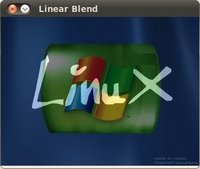1
2
3
4
5
6
7
8
9
10
11
12
13
14
15
16
17
18
19
20
21
22
23
24
25
26
27
28
29
30
31
32
33
34
35
36
37
38
39
40
41
42
43
44
45
46
47
48
49
50
51
52
53
54
55
56
57
58
59
60
61
62
63
64
65
66
67
68
69
70
71
72
73
74
75
76
77
78
79
80
81
82
83
84
85
86
87
88
89
90
91
92
93
94
95
96
97
98
99
100
101
102
103
104
105
106
107
108
109
110
111
112
113
114
115
116
117
118
119
120
121
122
123
|
Adding (blending) two images using OpenCV {#tutorial_adding_images}
=========================================
@tableofcontents
@prev_tutorial{tutorial_mat_operations}
@next_tutorial{tutorial_basic_linear_transform}
| | |
| -: | :- |
| Original author | Ana Huamán |
| Compatibility | OpenCV >= 3.0 |
We will learn how to blend two images!
Goal
----
In this tutorial you will learn:
- what is *linear blending* and why it is useful;
- how to add two images using **addWeighted()**
Theory
------
@note
The explanation below belongs to the book [Computer Vision: Algorithms and
Applications](http://szeliski.org/Book/) by Richard Szeliski
From our previous tutorial, we know already a bit of *Pixel operators*. An interesting dyadic
(two-input) operator is the *linear blend operator*:
\f[g(x) = (1 - \alpha)f_{0}(x) + \alpha f_{1}(x)\f]
By varying \f$\alpha\f$ from \f$0 \rightarrow 1\f$ this operator can be used to perform a temporal
*cross-dissolve* between two images or videos, as seen in slide shows and film productions (cool,
eh?)
Source Code
-----------
@add_toggle_cpp
Download the source code from
[here](https://raw.githubusercontent.com/opencv/opencv/4.x/samples/cpp/tutorial_code/core/AddingImages/AddingImages.cpp).
@include cpp/tutorial_code/core/AddingImages/AddingImages.cpp
@end_toggle
@add_toggle_java
Download the source code from
[here](https://raw.githubusercontent.com/opencv/opencv/4.x/samples/java/tutorial_code/core/AddingImages/AddingImages.java).
@include java/tutorial_code/core/AddingImages/AddingImages.java
@end_toggle
@add_toggle_python
Download the source code from
[here](https://raw.githubusercontent.com/opencv/opencv/4.x/samples/python/tutorial_code/core/AddingImages/adding_images.py).
@include python/tutorial_code/core/AddingImages/adding_images.py
@end_toggle
Explanation
-----------
Since we are going to perform:
\f[g(x) = (1 - \alpha)f_{0}(x) + \alpha f_{1}(x)\f]
We need two source images (\f$f_{0}(x)\f$ and \f$f_{1}(x)\f$). So, we load them in the usual way:
@add_toggle_cpp
@snippet cpp/tutorial_code/core/AddingImages/AddingImages.cpp load
@end_toggle
@add_toggle_java
@snippet java/tutorial_code/core/AddingImages/AddingImages.java load
@end_toggle
@add_toggle_python
@snippet python/tutorial_code/core/AddingImages/adding_images.py load
@end_toggle
We used the following images: [LinuxLogo.jpg](https://raw.githubusercontent.com/opencv/opencv/4.x/samples/data/LinuxLogo.jpg) and [WindowsLogo.jpg](https://raw.githubusercontent.com/opencv/opencv/4.x/samples/data/WindowsLogo.jpg)
@warning Since we are *adding* *src1* and *src2*, they both have to be of the same size
(width and height) and type.
Now we need to generate the `g(x)` image. For this, the function **addWeighted()** comes quite handy:
@add_toggle_cpp
@snippet cpp/tutorial_code/core/AddingImages/AddingImages.cpp blend_images
@end_toggle
@add_toggle_java
@snippet java/tutorial_code/core/AddingImages/AddingImages.java blend_images
@end_toggle
@add_toggle_python
@snippet python/tutorial_code/core/AddingImages/adding_images.py blend_images
Numpy version of above line (but cv function is around 2x faster):
\code{.py}
dst = np.uint8(alpha*(img1)+beta*(img2))
\endcode
@end_toggle
since **addWeighted()** produces:
\f[dst = \alpha \cdot src1 + \beta \cdot src2 + \gamma\f]
In this case, `gamma` is the argument \f$0.0\f$ in the code above.
Create windows, show the images and wait for the user to end the program.
@add_toggle_cpp
@snippet cpp/tutorial_code/core/AddingImages/AddingImages.cpp display
@end_toggle
@add_toggle_java
@snippet java/tutorial_code/core/AddingImages/AddingImages.java display
@end_toggle
@add_toggle_python
@snippet python/tutorial_code/core/AddingImages/adding_images.py display
@end_toggle
Result
------

|